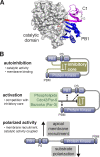Cooperative regulation of C1-domain membrane recruitment polarizes atypical protein kinase C
- PMID: 37589718
- PMCID: PMC10435729
- DOI: 10.1083/jcb.202112143
Cooperative regulation of C1-domain membrane recruitment polarizes atypical protein kinase C
Abstract
Recruitment of the Par complex protein atypical protein kinase C (aPKC) to a specific membrane domain is a key step in the polarization of animal cells. While numerous proteins and phospholipids interact with aPKC, how these interactions cooperate to control its membrane recruitment has been unknown. Here, we identify aPKC's C1 domain as a phospholipid interaction module that targets aPKC to the membrane of Drosophila neural stem cells (NSCs). The isolated C1 binds the NSC membrane in an unpolarized manner during interphase and mitosis and is uniquely sufficient among aPKC domains for targeting. Other domains, including the catalytic module and those that bind the upstream regulators Par-6 and Bazooka, restrict C1's membrane targeting activity-spatially and temporally-to the apical NSC membrane during mitosis. Our results suggest that aPKC polarity results from cooperative activation of autoinhibited C1-mediated membrane binding activity.
© 2023 Jones et al.
Conflict of interest statement
Disclosures: The authors declare no competing interests exist.
Figures







Similar articles
-
A Conserved PDZ-Binding Motif in aPKC Interacts with Par-3 and Mediates Cortical Polarity.Curr Biol. 2020 Mar 9;30(5):893-898.e5. doi: 10.1016/j.cub.2019.12.055. Epub 2020 Feb 20. Curr Biol. 2020. PMID: 32084408 Free PMC article.
-
A polybasic domain in aPKC mediates Par6-dependent control of membrane targeting and kinase activity.J Cell Biol. 2020 Jul 6;219(7):e201903031. doi: 10.1083/jcb.201903031. J Cell Biol. 2020. PMID: 32580209 Free PMC article.
-
Polarization of Drosophila neuroblasts during asymmetric division.Cold Spring Harb Perspect Biol. 2009 Aug;1(2):a001388. doi: 10.1101/cshperspect.a001388. Cold Spring Harb Perspect Biol. 2009. PMID: 20066083 Free PMC article. Review.
-
Partitioning-defective protein 6 (Par-6) activates atypical protein kinase C (aPKC) by pseudosubstrate displacement.J Biol Chem. 2012 Jun 15;287(25):21003-11. doi: 10.1074/jbc.M112.360495. Epub 2012 Apr 27. J Biol Chem. 2012. PMID: 22544755 Free PMC article.
-
The PAR-aPKC system: lessons in polarity.J Cell Sci. 2006 Mar 15;119(Pt 6):979-87. doi: 10.1242/jcs.02898. J Cell Sci. 2006. PMID: 16525119 Review.
Cited by
-
The Drosophila neuroblast polarity cycle at a glance.J Cell Sci. 2024 Mar 1;137(5):jcs261789. doi: 10.1242/jcs.261789. Epub 2024 Mar 11. J Cell Sci. 2024. PMID: 38465513 Free PMC article.
-
Into the fold: advances in understanding aPKC membrane dynamics.Biochem J. 2023 Dec 20;480(24):2037-2044. doi: 10.1042/BCJ20230390. Biochem J. 2023. PMID: 38100320 Free PMC article.
-
Membrane extraction in native lipid nanodiscs reveals dynamic regulation of Cdc42 complexes during cell polarization.Biophys J. 2025 Mar 18;124(6):876-890. doi: 10.1016/j.bpj.2023.11.021. Epub 2023 Nov 23. Biophys J. 2025. PMID: 38006206 Free PMC article.
-
Control of atypical PKCι membrane dissociation by tyrosine phosphorylation within a PB1-C1 interdomain interface.J Biol Chem. 2023 Jul;299(7):104847. doi: 10.1016/j.jbc.2023.104847. Epub 2023 May 20. J Biol Chem. 2023. PMID: 37211093 Free PMC article.
-
Atypical Protein Kinase C Promotes its own Asymmetric Localisation by Phosphorylating Cdc42 in the C. elegans zygote.bioRxiv [Preprint]. 2024 Jun 14:2023.10.27.563985. doi: 10.1101/2023.10.27.563985. bioRxiv. 2024. PMID: 38009101 Free PMC article. Preprint.
References
Publication types
MeSH terms
Substances
Associated data
Grants and funding
LinkOut - more resources
Full Text Sources
Molecular Biology Databases
Miscellaneous

